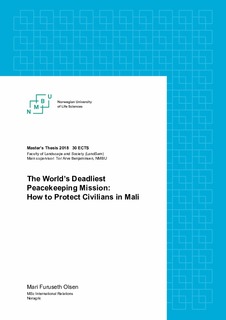| dc.description.abstract | Since 2012, Mali has experienced a rapid escalation of violence as political armed groups, including ethnic and jihadist rebel groups and transnational networks, fight for control and hegemony in the north and central parts of Mali. During the conflict, civilians have been victims of summary executions and enforced disappearances by perpetrating rebel groups and parts of the Malian defence and security forces. The violence led to the deployment of the ongoing United Nations peacekeeping mission, known by its acronym MINUSMA. The mission was deployed to a conflict where there was no peace to hold and has since its deployment in 2013 experienced a challenging and hostile conflict environment. This thesis sets out to explore and explain the violence against civilians in Mali carried out by rebel groups and government forces from the uprisings in 2012 until 2018. The thesis uses the threat-based scenario framework developed by the Norwegian Defence Research Establishment (FFI) in trying to identify the threats civilians in Mali have faced and how military forces have protected civilians in different times and different places throughout the armed conflict. The thesis finds that the conflict in Mali can be divided into three different phases where each phase represents an escalation or a change in the violence against civilians. The first phase, from 2012 to 2013, was mainly characterised by armed rebel groups who fought for control in the north of Mali in a classic scenario of Insurgency. In the second phase, from 2013 to 2016, the violence against civilians escalated to a scenario of Government Repression after parts of the Malian armed forces attacked individuals perceived to be in opposition or affiliated with the rebel groups from phase 1. In the third phase, from 2017 to 2018, the violence evolved into a Communal Conflict in central Mali where the main motivation for targeting civilians was based communal identity, the desire for revenge and as act of self-protection and survival. Regarding the military’s protection of civilians during these phases of the conflict, the thesis finds that both MINUSMA and other military forces have struggled with protecting civilians from imminent threat. The difficult geographic environment in Mali, the lack of resources and the many asymmetrical attacks on the peacekeepers have forced the mission to take on a defensive role, which has limited its ability to protect civilians. | nb_NO |

